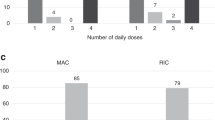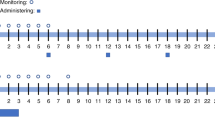Abstract
With intravenous administration of busulfan (Busilvex®), the therapeutic range of the drug is achieved in more paediatric patients than after oral busulfan administration. In clinical trials in paediatric and adult patients, intravenous busulfan-based preconditioning treatment regimen prior to haematopoietic progenitor cell transplantation (HPCT) provided high rates of engraftment, low transplant-related mortality rates and good overall survival and progression-free survival outcomes. Intravenous busulfan was considered to have an acceptable tolerability profile.



Similar content being viewed by others
References
Fisher VL, Barnes YJ, Nuss SL. Pretransplant conditioning in adults and children: dose assurance with intravenous busulfan. Oncol Nurs Forum 2006 Mar; 33(2): E36–43
Léger CS, Nevill TJ. Hematopoietic stem cell transplantation: a primer for the primary care physician. CMAJ 2004 May 11; 170(10): 1569–77
Busilvex: European Public Assessment Report. London: European Medicines Agency, 2012 Mar 27
Buggia L, Locatelli F, Regazzi M-B, et al. Busulfan. Ann Pharmacother 1994; 28(9): 1055–62
Busilvex: summary of product characteristics. London: European Medicines Agency, 2012 Mar 27
Vassal G, Michel G, Esperou H, et al. Prospective validation of a novel IV busulfan fixed dosing for paediatric patients to improve therapeutic AUC targeting without drug monitoring. Cancer Chemother Pharmacol 2008; 61: 113–23
Wall DA, Chan KW, Nieder ML, et al. Safety, efficacy, and pharmacokinetics of intravenous busulfan in children undergoing allogenic hematopoietic stem cell transplantation. Pediatr Blood Cancer 2010; 54(2): 291–8
Michel G, Valteau-Couanet D, Gentet J-C, et al. Weight-based strategy of dose administration in children using intravenous busulfan: clinical and pharmacokinetic results. Pediatr Blood Cancer 2012; 58(1): 90–7
Lemaistre JA, Bachier C, Smith B, et al. Once daily busulfan cyclophosphamide regimen is well tolerated and effective as a preparative regimen for allogenic hematopoietic stem cell transplant. J Oncol Pharm Pract 2012; 18(1): 17–22
Tang W, Wang L, Zhao WL, et al. Intravenous busulfan-cyclophosphamide as a preparative regimen before allogenic hematopoietic stem cell transplantation for adult patients with acute lymphoblastic leukemia. Biol Blood Marrow Transplant 2011; 17(10): 1555–61
Escalón MP, Stefanovic A, Venkatraman A, et al. Autologous transplantation for relapsed non-Hodgkin’s lym-phoma using intravenous busulfan and cyclophosphamide as conditioning regimen: a single center experience. Bone Marrow Transplant 2009; 44(2): 89–96
Sobecks RM, Rybicki L, Yurch M, et al. Intravenous compared with oral busulfan as preparation for allogenic hematopoietic progenitor cell transplantation for AML and MDS. Bone Marrow Transplant 2011. Epub 2011 Aug 29
Michel G, Valteau-Counanet, D, Esperou, H. A new I.V. busulfan fixed dosing for conditioning before autologous or allogeneic hematopoietic stem cell transplantation in children with malignant and non-malignant diseases: pharmacokinetics, toxicity and clinical outcomes [abstract no. 1758]. Blood 2005; 106(11 Pt 1): 500a. Plus poster presented at the 47th Annual Meeting of the American Society of Hematology; 2005 Dec 10–13; Atlanta (GA)
Vassal G, Koscielny S, Challine D, et al. Busulfan disposition and hepatic veno-occlusive disease in children undergoing bone marrow transplantation. Cancer Chemother Pharmacol 1996; 37(3): 247–53
Hassan M. The role of busulfan in bone marrow transplantation. Med Oncol 1999; 16(3): 166–76
Lee JL, Gooley T, Bensinger W, et al. Veno-occlusive disease of the liver after busulfan, melphalan, and thiotepa conditioning therapy: incidence, risk factors, and outcome. Biol Blood Marrow Transplant 1999; 5(5): 306–15
Hempel G, Oechtering D, Lanvers-Kaminsky C, et al. Cyto-toxicity of dimethylacetamide and pharmacokinetics in children receiving intravenous busulfan. J Clin Oncol 2007 May 1; 25(13): 1772–8
Paci A, Vassal G, Moshous D, et al. Pharmacokinetic behavior and appraisal of intravenous busulfan dosing in infants and older children: the results of a population pharmacokinetic study from a large pediatric cohort undergoing hematopoietic stem-cell transplantation. Ther Drug Monit 2012 Apr; 34(2): 198–208
de Lima M, Couriel D, Thall PF, et al. Once-daily intravenous busulfan and fludarabine: clinical and pharmacokinetic results of a myeloablative, reduced-toxicity conditioning regimen for allogeneic stem cell transplantation in AML and MDS. Blood 2004 Aug 1; 104(3): 857–64
González-Vicent M, Molina B, Pérez A, et al. Once-daily intravenous busulfan for 47 pediatric patients undergoing autologous hematopoietic stem cell transplantation: a single center study. J Pediatr Hematol Oncol 2012 Apr; 34(3): 180–3
Russell JA, Tran HT, Quinlan D, et al. Once-daily intravenous busulfan given with fludarabine as conditioning for allogeneic stem cell transplantation: study of pharmacokinetics and early clinical outcomes. Biol Blood Marrow Transplant 2002; 8(9): 468–76
Madden T, de Lima M, Thapar N, et al. Pharmacokinetics of once-daily IV busulfan as part of pretransplantation preparative regimens: a comparison with an every 6-hour dosing schedule. Biol Blood Marrow Transplant 2007 Jan; 13(1): 56–64
Acknowledgements and Disclosures
This article was reviewed by G. Hempel, Westfälische Wilhelms-Universität Münster Institut für Pharmazeutische und Medizinische, Münster, Germany.
The preparation of this article was not supported by any external funding. During the peer review process, the manufacturer of the agent under review was offered an opportunity to comment on the article. Changes resulting from comments received were made by the authors on the basis of scientific and editorial merit.
Author information
Authors and Affiliations
Corresponding author
Rights and permissions
About this article
Cite this article
Scott, L.J., Hoy, S.M. & Lyseng-Williamson, K.A. Intravenous Busulfan: A Guide to Its Use as Conditioning Treatment before Transplantation of Haematopoietic Progenitor Cells. Clin Drug Investig 32, 641–648 (2012). https://doi.org/10.1007/BF03261918
Published:
Issue Date:
DOI: https://doi.org/10.1007/BF03261918




